The opportunities to see great art are endless this summer! Heading to the West Coast for work? Take a detour and visit the newly opened Nordic Museum to check out Northern Exposure: Contemporary Nordic Arts Revealed in Seattle, Washington. Visiting friends or family in the Northeast? Make plans to spend the day in New Haven and see Text and Textile at The Beinecke Rare Book & Manuscript Library on Yale’s campus. Whether you are in the North, South, East or West there are a wide variety of strong exhibitions on display across the US this summer, here are a few of our favorites:
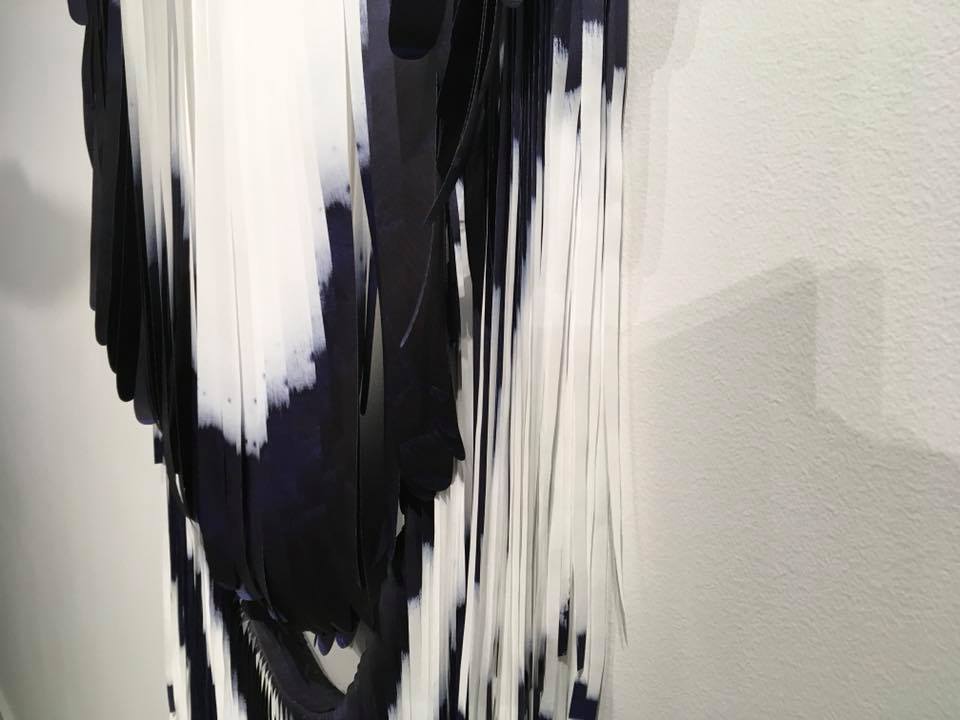
Grethe Wittrock’s Nordic Birds at the Nordic Museum in Seattle, Washington. Photo by Grethe Wittrock
Northern Exposure: Contemporary Nordic Arts Revealed at the Nordic Museum, Seattle, Washington
The newly opened Nordic Museum hopes to share and inspire people of all ages and backgrounds through Nordic art. The museum is the largest in the US to honor the legacy of immigrants from the five Nordic countries: Denmark, Finland, Iceland, Norway and Sweden. Northern Exposure studies “how the Nordic character continues to redefine itself within an evolving global context” by challenging “perceptions of form, gender, identity, nature, technology and the body,” explains the Museum. The exhibition features work by internationally acclaimed artists, including Grethe Wittrock, Olafur Eliasson, Bjarne Melgaard, Jesper Just, Kim Simonsson and Cajsa Von Zeipel. Made of Danish sailcloth, Wittrock’s Nordic Birds immediately attracts the eye upon entering the exhibition. Northern Exposure: Contemporary Nordic Arts Revealed will be on display through September 16, 2018. For more information click HERE.

Traces: Wonder by Lia Cook at the Racine Art Museum, Gift of Karen Johnson Boyd. Photo by Jon Bolton
Honoring Karen Johnson Boyd: Collecting In-Depth at Home and at RAM, Racine Art Museum, Wisconsin
The Racine Art Museum’s new exhibit Honoring Karen Johnson Boyd: Collecting In-Depth at Home and at RAM showcases art advocate and collector Karen Johnson Boyd’s collection of ceramic, clay and fiber art. The exhibition, which is broken up into a series of four individually titled exhibitions, with varying opening and closing dates, highlight Boyd’s interests, accomplishments and lifelong commitment to art. Throughout her life, Boyd was drawn to a diverse array of artistic styles and subjects. Boyd, who collected fiber in an encyclopedic fashion, supported artists of varying ages with varying regional, national and international reputations. Boyd’s Frank Lloyd Wright-designed home provided her with many display options for her fiber collection. Though baskets encompassed the majority of Boyd’s fiber collection, she regularly altered her environment, adding and subtracting works as she added to her collection. The exhibitions feature work from Dorothy Gill Barnes, Lia Cook, Kiyomi Iwata, Ferne Jacobs, John McQueen, Ed Rossbach, Hideho Tanaka, Mary Merkel-Hess, Norma Minkowitz, Lenore Tawney and Katherine Westphal. Honoring Karen Johnson Boyd: Collecting In-Depth at Home and at RAM will be on display at the Racine Art Museum through December 30th, with exhibited pieces changing over in mid-September. For more information on Honoring Karen Johnson Boyd: Collecting In-Depth at Home and at RAM visit the Racine Art Museum’s website HERE.

Text and Textile at The Beinecke Rare Book & Manuscript Library
Text and Textile at The Beinecke Rare Book & Manuscript Library, New Haven, Connecticut
In New Haven, Connecticut, The Beinecke Rare Book & Manuscript Library recently opened Text and Textile. The exhibition, which will be on display through August 12th, explores the relationship and intersection between text and textile in literature and politics.Text and Textile draws on Yale University’s phenomenal collection of literature tied to textiles, from Renaissance embroidered bindings to text from Anni Albers’ On Weaving. Additionally, the exhibition features: Gertrude Stein’s waistcoat; manuscript patterns and loom cards from French Jacquard mills; the first folio edition of William Shakespeare’s plays; the “Souper” paper dress by Andy Warhol; American samplers; Christa Wolf’s “Quilt Memories”; Zelda Fitzgerald’s paper dolls for her daughter; Edith Wharton’s manuscript drafts of “The House of Mirth”; an Incan quipu; poetry by Langston Hughes, Emily Dickinson, Susan Howe and Walt Whitman; and “The Kelmscott Chaucer” by William Morris. For more information on Text and Textile click HERE.
Rooted, Revived, Reinvented: Basketry In America at the Houston Center for Contemporary Craft. Houston, Texas
The traveling exhibition Rooted, Revived, Reinvented: Basketry In America is now on display at the Houston Center for Contemporary Craft in Houston, Texas. The exhibition, which is set to travel around the United States through the end of 2019, chronicles the history of American basketry from its origins in Native American, immigrant and slave communities to its presence within the contemporary fine art world. Curated by Josephine Stealy and Kristin Schwain, the exhibition is divided into five sections: Cultural Origins, New Basketry, Living Traditions, Basket as Vessel and Beyond the Basket which aim to show you the evolution of basketry in America. Today, some contemporary artists seek to maintain and revive traditions practiced for centuries. However, other work to combine age-old techniques with nontraditional materials to generate cultural commentary. Rooted, Revived, Reinvented: Basketry In America features work by browngrotta arts’ artists Polly Adams Sutton, Mary Giles, Nancy Moore Bess, Christine Joy, Nancy Koenigsberg, Dorothy Gill Barnes, Ferne Jacobs, Gyöngy Laky, Kari Lønning, John McQueen, Norma Minkowitz, Leon Niehues, Ed Rossbach, Karyl Sisson and Kay Sekimachi.
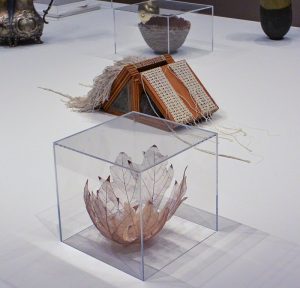
Kay Sekimachi in Handheld at the Aldrich Museum. Photo by Tom Grotta
Handheld at the Aldrich Museum, Ridgefield, Connecticut
The Aldrich Museum’s new exhibition Handheld explores how contemporary artists’ and designers’ perceive the meaning of touch. Touch is one of the most intimate and sometimes unappreciated senses. Today, the feeling our hands are most familiar with are our that of our handheld devices and electronics. Touch is no longer solely used to hold objects such as pencils and tools, in fact, touch is increasingly taking the form of a swipe, where the sensation is ignored in favor to the flat visual landscapes of our own selection. “Handheld takes a multifarious approach—the hand as means of creation, a formal frame of reference” explains the Aldrich Museum. It serves the viewer as “a source of both delight and tension as they experience sensual objects in familiar domestic forms, scaled for touch, that can be looked upon but not felt.” The group exhibition, which features work by Kay Sekimachi will be on display until January 13, 2019. For more information on Handheld click HERE.

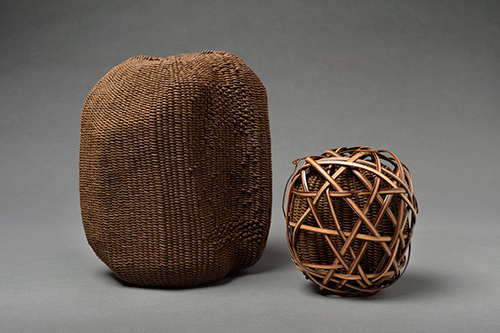
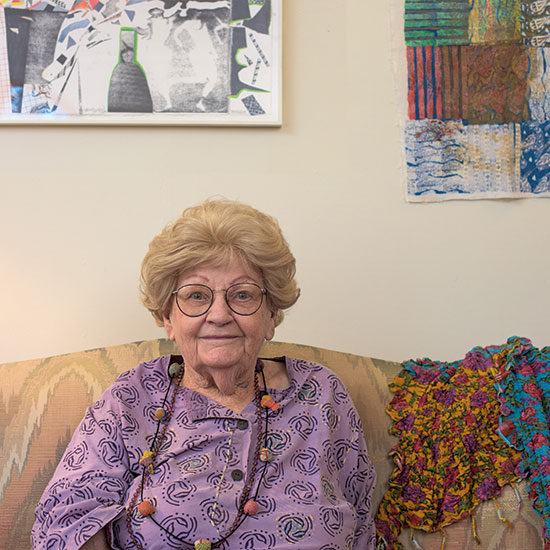



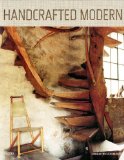
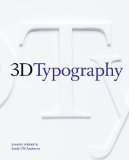








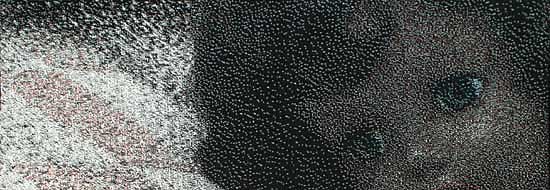
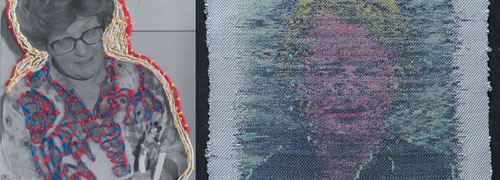

The Resurgence of Interest in Fiber Sculpture and Art Textiles Will Continue in 2015
Last year was an extraordinary one for those of us who appreciate contemporary art fiber and art textiles. More than 10 exhibitions opened in the US and abroad. In October, the art newspaper reported that “textiles are gaining international stature in art museums” and further that “[c]ommercial interest is on the rise,” quoting art advisor Emily Tsingou: “Textile [art] has entered the mainstream.” Soft Fabrics-Have Solid Appeal. Below is a roundup of exhibitions and reviews from last year and a guide to what to expect in 2015.
Mainstream attention began with the coverage of Sheila Hicks‘ inclusion
Sheila Hicks, Pillar of Inquiry/Supple Column, 2013-14 (installation view, Whitney Museum of American Art, New York). Photograph by Bill Orcutt
in the Whitney Biennial in March and was followed by coverage of the restoration of her remarkable 1960s tapestries at the Ford Foundation in New York Sheila Hicks Tapestries to Again Hang at Ford Foundation. In June, the Art Institute of Chicago’s textile galleries reopened, featuring 96-year-old Ethel Stein’s work, in Ethel Stein, Master Weaver.
September saw three fiber-related exhibitions; the Museum of Arts and Design opened What Would Mrs. Webb Do? A Founder’s Vision (closes
February 8, 2015),Kay Sekimachi, Ed Rossbach, Françoise Grossen, Katherine Westphal and others Museum of Art Design installation of What Would Mrs Webb Do?, Photo by Tom grotta
February 8, 2015), which featured significant textiles from the permanent collection by Anni Albers, Kay Sekimachi, Katherine Westphal, Ed Rossbach, Françoise Grossen and Trude Guermonprez, while The Drawing Center’s: Thread-Lines offered Anne Wilson creating fiber art in situ
Ann Wilson’s In Situ Performance at the Drawing Center, photo by Tom Grotta
together with a collection of works by Lenore Tawney, Louise Bourgeois and others. Contemporary 108 in Tulsa, Oklahoma, featured a series of large photographic weavings by Aleksandra Stoyanov of the Ukraine
Contemporary 108 in Tulsa, Oklahoma, curated from the 2013 “Aleksandra Stoyanov” Tefen Open Museum, Israel exhibition. photo copyright Tefen Open Museum
and now Israel, described as “warp and weft paintings.”
In October, Fiber: Sculpture 1960 – present, opened at the Institute of Contemporary Art in Boston with works by 34 artists including
Fiber: Sculpture 1960 — present opening, photo by Tom Grotta
Magdalena Abakanowicz, Ritzi Jacobi and Naomi Kobayashi. The Boston Globe called the exhibition “[s]plendid, viscerally engaging…groundbreaking;” the exhibition catalog (available at browngrotta.com) was pronounced by Blouin art info, “an amazing resource for anyone interested in learning more about the medium.” Art Info – Art in the Air Fiber Sculpture 1960 Present October also saw a survey of the work of sculptor and poet, Richard Tuttle, at the Tate in London, Richard Tuttle:
I Don’t Know, Or The Weave of Textile Language in which Tuttle investigated the importance of textiles throughout history, across his remarkable body of work and into the latest developments in his practice. Tate Modern – Richard Tuttle I Don’t Know or Weave Textile Language
Throughout the year, Innovators and Legends, with work by 50 fiber
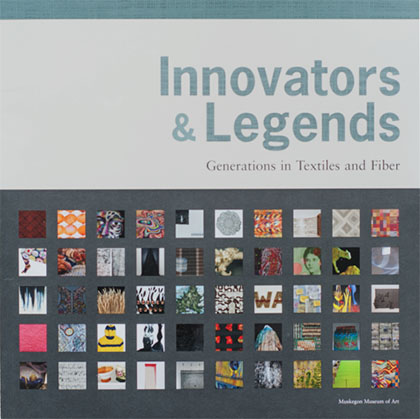
artists, including Adela Akers, Nick Cave, Katherine Westphal and Sherri Smith toured the US, exhibiting at museums in Colorado, Iowa and Kentucky. The fiber fanfest culminated at Art Basel in Miami Beach in December, where Blouin’s Art Info identified a full complement of fiber works and textiles in its listing, “Definitive Top 11 Booths, “ including Alexandra da Cunha’s compositions of mass-produced beach towels and various colored fabrics at Thomas Dane Gallery, a Rosemarie Trockel embroidered work at Galerie 1900-2000, marble and dyed-fabric pieces by Sam Moyer at Galerie Rodolphe Janssen and woven paintings by Brent Wadden at Mitchell-Innes & Nash Blouin Art info – The Definitive Top-11 Booths at Art Basel Miami Beach.
And what’s ahead in 2015?
More auctions and exhibitions that include fiber sculpture and art textiles are scheduled for 2015. Fiber: Sculpture 1960 – present will
open at the Wexner Center for the Arts, Columbus, Ohio on February 7th and travel to the Des Moines Art Center, Iowa in May.
Sonia Delaunay Prismes electriques 1914 Centre Pompidou Collection, Mnam / Cci, Paris © Pracusa 2013057
dedicated her life to experimenting with color and abstraction, bringing her ideas off the canvas and into the world through tapestry, textiles, mosaic and fashion.
Also in April, the Museum of Arts and Design will host Pathmakers:
Lenore Tawney in her Coenties Slip studio, New York, 1958.
Courtesy of Lenore G. Tawney Foundation; Photo by David Attie
Women in Art, Craft and Design, Midcentury and Today, featuring work by Sheila Hicks, Lenore Tawney and Dorothy Liebes http://madmuseum.org/exhibition/pathmakers.
In June, the Toms Pauli Foundation in Lausanne, Switzerland will celebrate the International Tapestry Biennials held there from 1962 to 1995 and display work by the Polish textile artist and sculptor Magdalena Abakanowicz, in an exhibition entitled, Objective Station.
1995 and display work by the Polish textile artist and sculptor Magdalena Abakanowicz, in an exhibition entitled, Objective Station.
Also this summer, the Musée d’Art Contemporain de Baie St Paul in
Mariette Rousseau Vermette Portrait by Tom Grotta
Quebec, Canada will examine the work of Mariette Rousseau-Vermette, who participated in five of the Lausanne Biennials.
From April 24 – May 3, 2015, browngrotta arts will host Influence and Evolution, Fiber Sculpture then and now at our barn/home/gallery space in Wilton, Connecticut. In its 27-year history, browngrotta arts
Françoise Grossen, From the Mermaid Series IV, 1983, photo by Tom Grotta
including Magdalena Abakanowicz, Lia Cook, Kay Sekimachi and Françoise Grossen, with works from a later generation of artists, all born after 1960, through whom fiber sculpture continues to evolve. These artists, including María Eugenia Dávila and Eduardo Portillo of Venezuela, Stéphanie Jacques of Belgium and Naoko Serino of Japan, work in a time when classification of medium and material presents less of a constraint and fiber and fiber techniques can be more readily explored for their expressive potential alone.
“It is rare to find so many inventive, compelling works in one show, and it astounds that many are so little known,” wrote Kirsten Swenson in Art in America, about Fiber: Sculpture 1960 – present, in October 2014. Art in America Magazine – reviews: Fiber Sculpture 1960-present. This spring, in Influence and Evolution, browngrotta arts will offer dozens more significant works of fiber art for collectors to appreciate and new audiences to discover — more than two dozen works by fiber pioneers and another 30 more recent fiber explorations. We hope you will visit the exhibition, order the catalog or both. Please contact us for more information about what’s in store. art@browngrotta.com